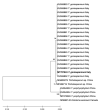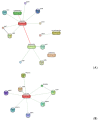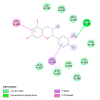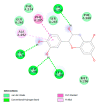Evaluation of Antioxidant, Antimicrobial and Tyrosinase Inhibitory Activities of Extracts from Tricholosporum goniospermum, an Edible Wild Mushroom
- PMID: 32823710
- PMCID: PMC7460263
- DOI: 10.3390/antibiotics9080513
Evaluation of Antioxidant, Antimicrobial and Tyrosinase Inhibitory Activities of Extracts from Tricholosporum goniospermum, an Edible Wild Mushroom
Abstract
Tricholosporum goniospermum (Bres.) Guzmán ex T.J. Baroni is an excellent edible mushroom whose compounds and biological properties are still unknown. In this study, n-hexane, ethyl acetate and methanol extracts from fruiting bodies and liquid-cultured mycelia were compared for the analysis of phenolic compounds, the evaluation of scavenger (DPPH, ABTS) and reducing (CUPRAC, FRAP) activities, and the enzyme inhibition of α-amylase, acetylcholinesterase (AChE), butyrylcholinesterase (BChE) and tyrosinase. Additionally, T. goniospermum extracts were evaluated for antibacterial and antimycotic activities against Gram+ and Gram- bacteria, and clinical yeast and fungal dermatophytes. Finally, based on the extract content in phenolic compounds, in silico studies, including the docking approach, were conducted to predict the putative targets (namely tyrosinase, lanosterol-14-α-demethylase, the multidrug efflux system transporters of E. coli (mdtK) and P. aeruginosa (pmpM), and S. aureus β-lactamase (ORF259)) underlying the observed bio-pharmacological and microbiological effects. The methanolic extract from mycelia was the richest in gallic acid, whereas the ethyl acetate extract from fruiting bodies was the sole extract to show levels of catechin. Specifically, docking runs demonstrated an affinity of catechin towards all docked proteins, in the micromolar range. These in silico data are consistent, at least in part, with the highest activity of ethyl acetate extract as an antimicrobial and anti-tyrosinase (554.30 mg KAE/g for fruiting bodies and 412.81 mg KAE/g for mycelia) agent. The ethyl acetate extracts were also noted as being the most active (2.97 mmol ACAE/g for fruiting bodies and 2.25 mmol ACAE/g for mycelia) on α-amylase. BChE inhibitory activities varied from 2.61 to 26.78 mg GALAE/g, while the tested extracts were not active on AChE. In conclusion, all mushroom extracts tested in this study had potent antimicrobial activities. Particularly, among the tested extracts, the ethyl acetate extract showed the highest efficacy as both an antimicrobial and anti-tyrosinase agent. This could be related, albeit partially, to its content of catechin. In this regard, the bioinformatics analyses showed interactions of catechin with tyrosinase and specific microbial proteins involved in the resistance to chemotherapeutic drugs, thus suggesting innovative pharmacological applications of T. goniospermum extracts.
Keywords: Tricholosporum goniospermum; anti-tyrosinase activity; antimicrobial activity; scavenger-reducing activity.
Conflict of interest statement
The authors declare no conflict of interest.
Figures







References
-
- Angelini P., Arcangeli A., Bistocchi G., Rubini A., Venanzoni R., Perini C. Current knowledge of Umbrian macrofungi (central Italy) Plant Biosyst. Int. J. Deal. Asp. Plant Biol. 2017;151:915–923. doi: 10.1080/11263504.2016.1265609. - DOI
-
- Angelini P., Bistocchi G., Arcangeli A., Rubini A., Venanzoni R. Inventory, diversity and communities of macrofungi in the Collestrada forest (Umbria, central Italy) Plant Biosyst. Int. J. Deal. Asp. Plant Biol. 2016;150:1096–1105. doi: 10.1080/11263504.2015.1108939. - DOI
-
- Angelini P., Pagiotti R., Granetti B. Effect of antimicrobial activity of Melaleuca alternifolia essential oil on antagonistic potential of Pleurotus species against Trichoderma harzianum in dual culture. World J. Microbiol. Biotechnol. 2008;24:197–202. doi: 10.1007/s11274-007-9456-x. - DOI
-
- Angelini P., Pagiotti R., Venanzoni R., Granetti B. Antifungal and allelopathic effects of Asafoetida against Trichoderma harzianum and Pleurotus spp. Allelopath. J. 2009;23:357–368.
LinkOut - more resources
Full Text Sources
Molecular Biology Databases
Miscellaneous

